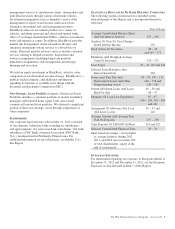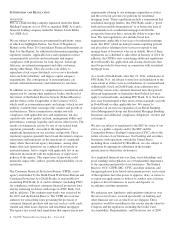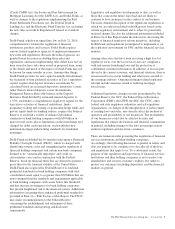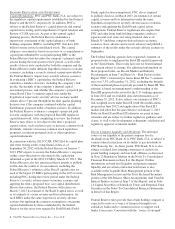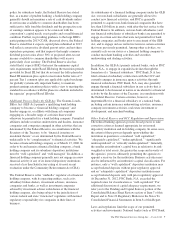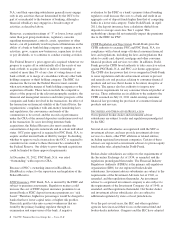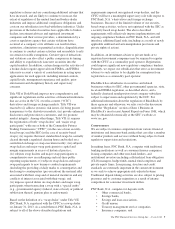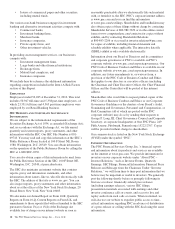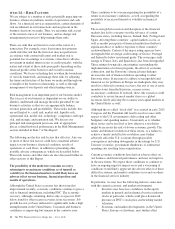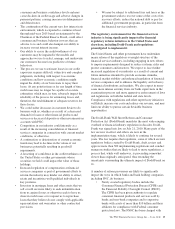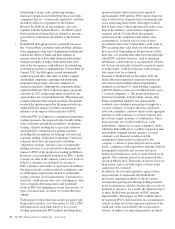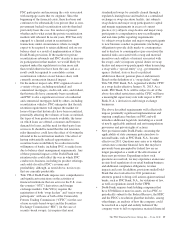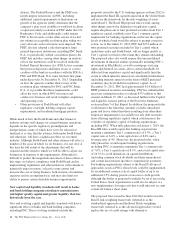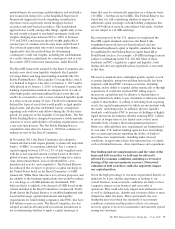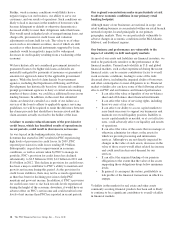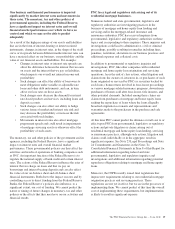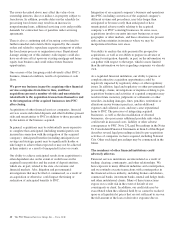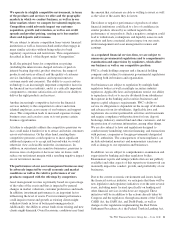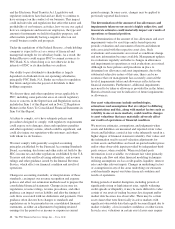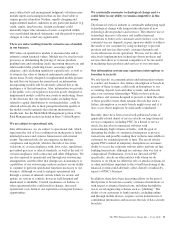PNC Bank 2012 Annual Report Download - page 32
Download and view the complete annual report
Please find page 32 of the 2012 PNC Bank annual report below. You can navigate through the pages in the report by either clicking on the pages listed below, or by using the keyword search tool below to find specific information within the annual report.consumer and business confidence levels and may
cause declines in credit usage and adverse changes in
payment patterns, causing increases in delinquencies
and default rates.
• The continuation of the current very low interest rate
environment, which is expected to continue at least
through mid-year 2015 based on statements by the
Chairman of the Federal Reserve Board, could affect
consumer and business behavior in ways that are
adverse to us and could also hamper our ability to
increase our net interest income.
• Our ability to assess the creditworthiness of our
customers may be impaired if the models and
approaches we use to select, manage, and underwrite
our customers become less predictive of future
behaviors.
• The process we use to estimate losses in our credit
exposures requires difficult, subjective and complex
judgments, including with respect to economic
conditions and how economic conditions might
impair the ability of our borrowers to repay their
loans. At any point in time or for any length of time,
such losses may no longer be capable of accurate
estimation, which may, in turn, adversely impact the
reliability of the process for estimating losses and,
therefore, the establishment of adequate reserves for
those losses.
• We could suffer decreases in customer desire to do
business with us, whether as a result of a decreased
demand for loans or other financial products and
services or decreased deposits or other investments in
accounts with PNC.
• Competition in our industry could intensify as a
result of the increasing consolidation of financial
services companies in connection with current market
conditions, or otherwise.
• A continuation or deterioration of current economic
trends may lead to declines in the values of our
businesses potentially resulting in goodwill
impairments.
• A lessening of confidence in the creditworthiness of
the United States or other governments whose
securities we hold could impact the value of those
holdings.
• Increased regulation of compensation at financial
services companies as part of government efforts to
reform the industry may hinder our ability to attract,
retain and incentivize well-qualified individuals in
key positions.
• Investors in mortgage loans and other assets that we
sell or sold are more likely to seek indemnification
from us against losses or otherwise seek to have us
share in such losses or to request us to repurchase
loans that they believe do not comply with applicable
representations and warranties or other contractual
provisions.
• We may be subject to additional fees and taxes as the
government seeks to recover some of the costs of its
recovery efforts, reduce the national debt or pay for
additional government programs, in particular from
the financial services industry.
The regulatory environment for the financial services
industry is being significantly impacted by financial
regulatory reform initiatives in the United States and
elsewhere, including Dodd-Frank and regulations
promulgated to implement it.
The United States and other governments have undertaken
major reform of the regulatory oversight structure of the
financial services industry, including engaging in new efforts
to impose requirements designed to reduce systemic risks and
protect consumers and investors. We expect to face further
increased regulation of our industry as a result of current and
future initiatives intended to provide economic stimulus,
financial market stability and enhanced regulation of financial
services companies and to enhance the liquidity and solvency
of financial institutions and markets. We also expect in many
cases more intense scrutiny from our bank supervisors in the
examination process and more aggressive enforcement of laws
and regulations on both the federal and state levels.
Compliance with regulations and other supervisory initiatives
will likely increase our costs and reduce our revenue, and may
limit our ability to pursue certain desirable business
opportunities.
The Dodd-Frank Wall Street Reform and Consumer
Protection Act (Dodd-Frank) mandates the most wide-ranging
overhaul of financial industry regulation in decades. Dodd-
Frank was signed into law on July 21, 2010. Many parts of the
law are now in effect and others are now in the
implementation stage, which is likely to continue for several
years. The law requires that regulators, some of which are new
regulatory bodies created by Dodd-Frank, draft, review and
approve more than 300 implementing regulations and conduct
numerous studies that are likely to lead to more regulations, a
process that, while well underway, is proceeding somewhat
slower than originally anticipated, thus extending the
uncertainty surrounding the ultimate impact of Dodd-Frank on
us.
A number of reform provisions are likely to significantly
impact the ways in which banks and bank holding companies,
including PNC, do business.
• Newly created regulatory bodies include the
Consumer Financial Protection Bureau (CFPB) and
the Financial Stability Oversight Council (FSOC).
The CFPB has been given authority to regulate
consumer financial products and services sold by
banks and non-bank companies and to supervise
banks with assets of more than $10 billion and their
affiliates for compliance with Federal consumer
protection laws. The FSOC has been charged with
The PNC Financial Services Group, Inc. – Form 10-K 13


